Brief Explanation of the Popularity of Bronze Statues
Bronze statues have gained immense popularity for several reasons. First, bronze is a durable and long-lasting material, ensuring the longevity of the artwork. Second, the unique aesthetic appeal of bronze, with its warm tone and a rich patina, adds a timeless and elegant touch to any space. Additionally, bronze statues are versatile and can be created in various sizes and styles, ranging from small tabletop sculptures to monumental public installations. The craftsmanship and intricate detailing involved in creating bronze statues showcase the skill and artistry of the sculptor. Furthermore, famous bronze statues have historical and cultural significance, often commemorating important figures or events. These factors contribute to the enduring popularity and widespread admiration for bronze statues in the art world and among collectors and enthusiasts alike.

Importance of bronze statues as cultural and artistic landmarks
Bronze statues hold significant importance as cultural and artistic landmarks. They serve as tangible representations of our history, traditions, and values. Bronze, known for its durability and ability to withstand the test of time, ensures the longevity of these sculptures, making them enduring symbols of our heritage.
As landmarks, bronze statues become iconic symbols of a city, region, or nation, attracting tourists and locals alike. They often depict influential figures, historical events, or cultural icons, allowing us to connect with our past and understand our collective identity.
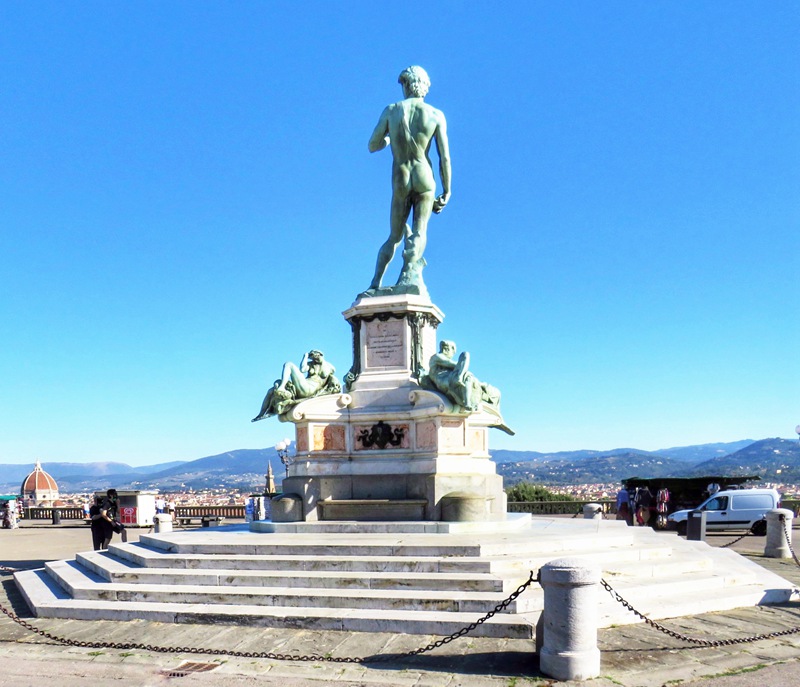
Beyond their historical and cultural significance, bronze statues are celebrated as exceptional works of art. The craftsmanship and artistry involved in their creation make them masterpieces that captivate and inspire. Their aesthetic beauty, intricate details, and skillful composition draw admiration from art enthusiasts worldwide.
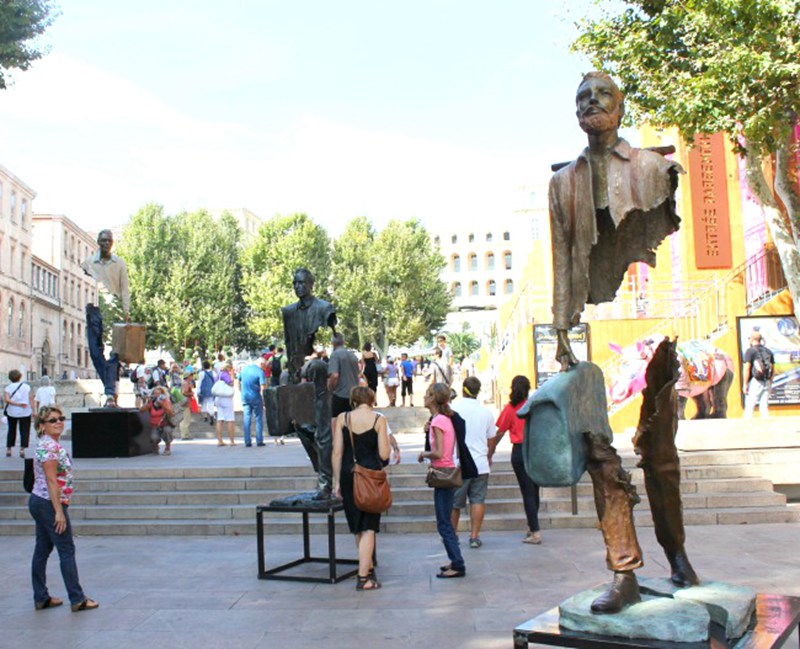
Moreover, bronze statues contribute to the enrichment of public spaces, creating focal points and gathering spots where people can appreciate and reflect upon the artwork. They enhance the aesthetic appeal of parks, plazas, and cityscapes, elevating the overall ambiance and making the environment more engaging and meaningful.
In summary, bronze statues serve as cultural and artistic landmarks that preserve our history, celebrate our heritage, and enrich our public spaces. They hold immense value as expressions of art, identity, and human creativity, leaving a lasting impact on both individuals and communities.
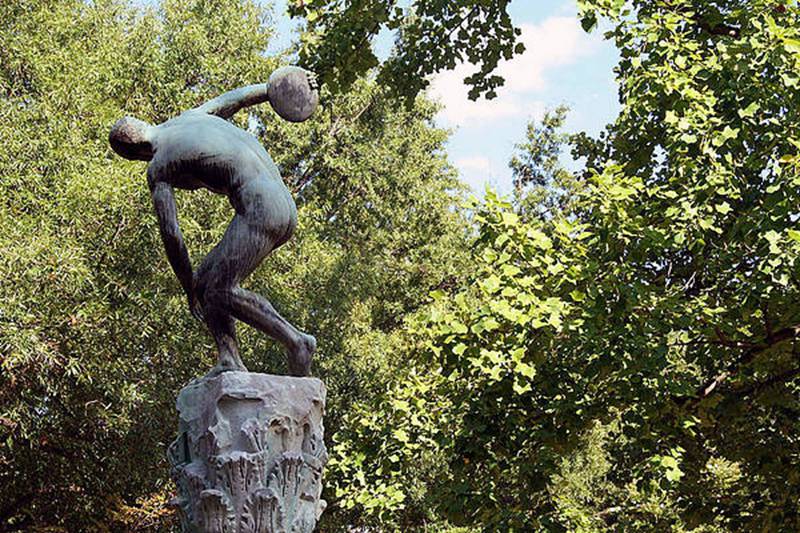
1. Statue of Liberty, USA
History and Significance of the Statue of Liberty
The Statue of Liberty, located in New York Harbor, is a world-renowned symbol of freedom and democracy. It holds immense historical and cultural significance, representing the enduring values of liberty, enlightenment, and hope.
The statue was a gift from the people of France to the United States and was designed by French sculptor Frédéric Auguste Bartholdi. It was dedicated on October 28, 1886, and has since become an iconic landmark.
The Statue of Liberty stands tall at 305 feet (93 meters) from the base to the tip of the torch. It depicts a female figure, robed in flowing garments, holding a torch in her right hand and a tablet in her left hand, on which is inscribed the date of the American Declaration of Independence, July 4, 1776.

The statue’s torch symbolizes enlightenment, representing the ideals of progress, knowledge, and freedom. The tablet she holds bears the words “July IV MDCCLXXVI,” symbolizing the founding principles of the United States.
As a beacon of hope, the Statue of Liberty welcomed millions of immigrants arriving in America in the late 19th and early 20th centuries. It served as a powerful symbol of freedom, offering a new beginning and the promise of a better life.
Today, the Statue of Liberty stands as a reminder of the importance of liberty and the American ideals of democracy and equality. It continues to inspire people from around the world, symbolizing the enduring pursuit of freedom and the strength of the human spirit.
Visitors can tour the statue and its pedestal, enjoying panoramic views of New York City and the surrounding areas. The statue remains a popular destination for tourists, a symbol of American values, and a testament to the power of freedom and unity.

2. The Thinker, France
Background and creation of The Thinker statue by Auguste Rodin
The Thinker, one of the most iconic sculptures in the world, was created by the renowned French sculptor Auguste Rodin. It was originally conceived as part of Rodin’s monumental bronze portal called “The Gates of Hell,” which was inspired by Dante’s Divine Comedy.
Rodin began working on The Thinker in 1880, and it was first exhibited as an independent piece in 1904. The statue depicts a nude male figure seated on a rock, deep in contemplation, with his chin resting on his hand and his elbow on his knee. The powerful and introspective pose of the figure embodies the intensity of thought and intellectual reflection.
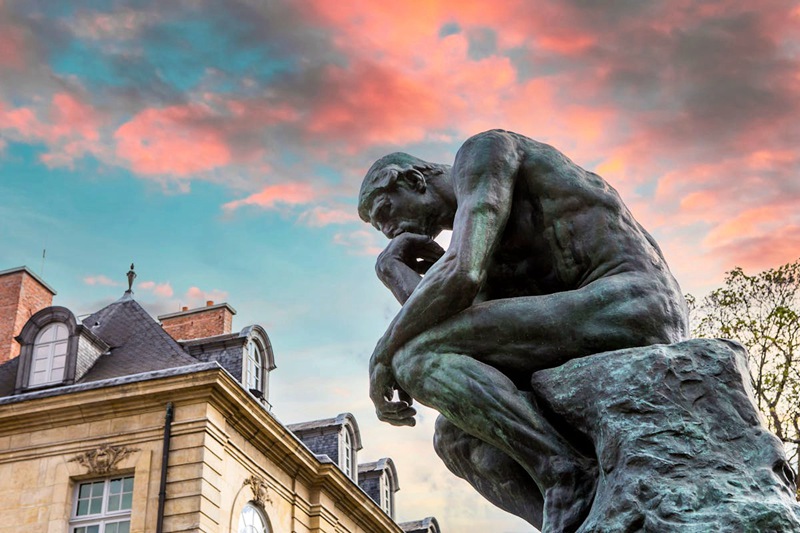
Rodin’s intention for The Thinker was to represent the universal human condition, showcasing the power of human intellect and the complexity of the human mind. The figure’s muscular physique symbolizes the strength and resilience of the human spirit in the face of life’s challenges and uncertainties.
The Thinker has become synonymous with philosophical and intellectual pursuits, and it has been celebrated as a representation of the power of human thought and contemplation. The sculpture has been widely reproduced and exhibited in various museums and public spaces around the world, solidifying its status as an iconic work of art.
Rodin’s innovative approach to sculpting, characterized by his emphasis on capturing the human form’s dynamic and emotional qualities, revolutionized the art world and influenced generations of artists. The Thinker, with its timeless and universal theme, continues to inspire and captivate audiences, inviting them to ponder the mysteries of the human mind and the depths of human existence.
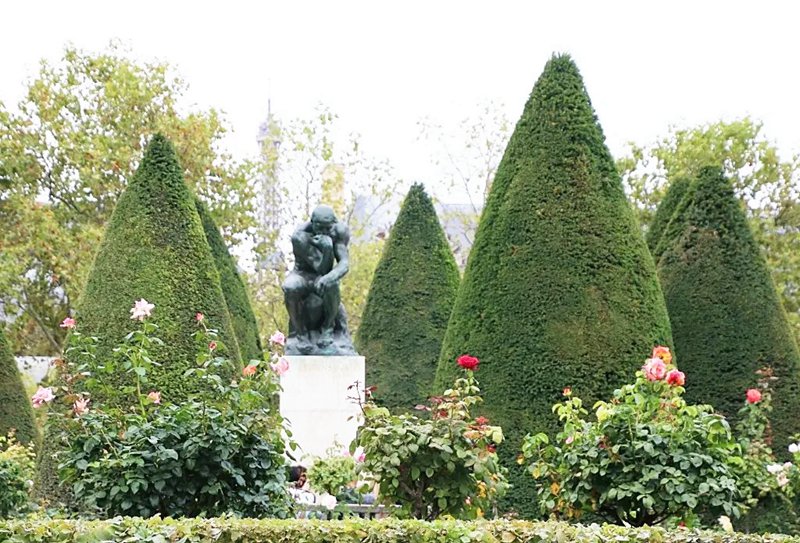
3. Little Mermaid, Denmark
The story behind the creation of the Little Mermaid statue
The Little Mermaid statue is an iconic bronze sculpture located in Copenhagen, Denmark. It was inspired by the beloved fairy tale written by Danish author Hans Christian Andersen. The statue was commissioned by brewer Carl Jacobsen and created by sculptor Edvard Eriksen.
The story behind the creation of the Little Mermaid statue dates back to 1909 when Carl Jacobsen saw a ballet performance based on Hans Christian Andersen’s fairy tale. Moved by the story, Jacobsen decided to commemorate the author and his famous tale by commissioning a statue.
Eriksen, known for his expertise in figurative sculptures, was chosen to bring the statue to life. The statue depicts a mermaid sitting on a rock by the water’s edge, gazing out into the sea. Eriksen’s wife, Eline Eriksen, served as the model for the statue.
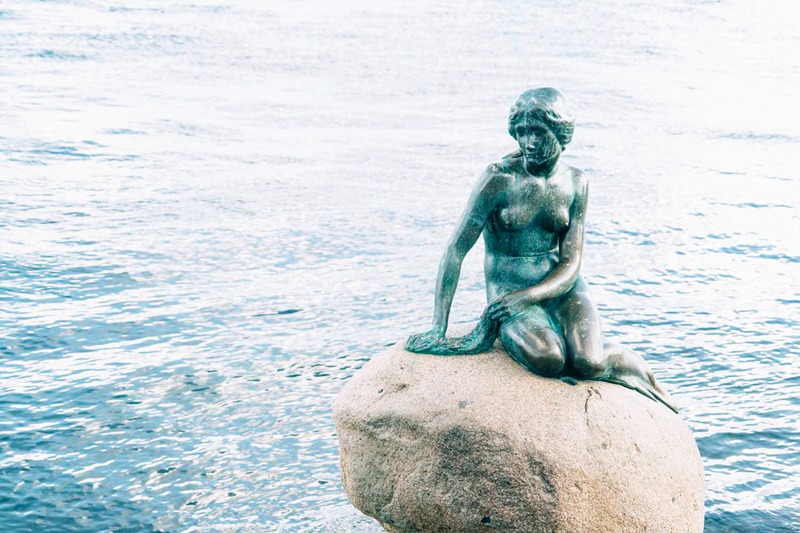
The Little Mermaid statue was unveiled on August 23, 1913, and immediately captured the hearts of locals and visitors alike. However, the statue’s journey hasn’t been without challenges. Over the years, it has been subject to vandalism, including decapitation and removal from its pedestal, but it has always been restored and returned to its rightful place.
Today, the Little Mermaid statue is considered an emblem of Copenhagen and a major tourist attraction. It symbolizes the enchanting tale of the mermaid who longed for love and an immortal soul. Its enduring popularity and the emotional connection it evokes in people have made it an iconic and cherished piece of public art.

4. Charging Bull, USA
Origin and symbolism of the Charging Bull sculpture
The Charging Bull sculpture, also known as the Wall Street Bull, is a bronze artwork located in the financial district of Manhattan, New York City. Created by Italian-American artist Arturo Di Modica, the sculpture was initially installed without permission in December 1989 as a symbol of strength, resilience, and the bullish optimism of the stock market.
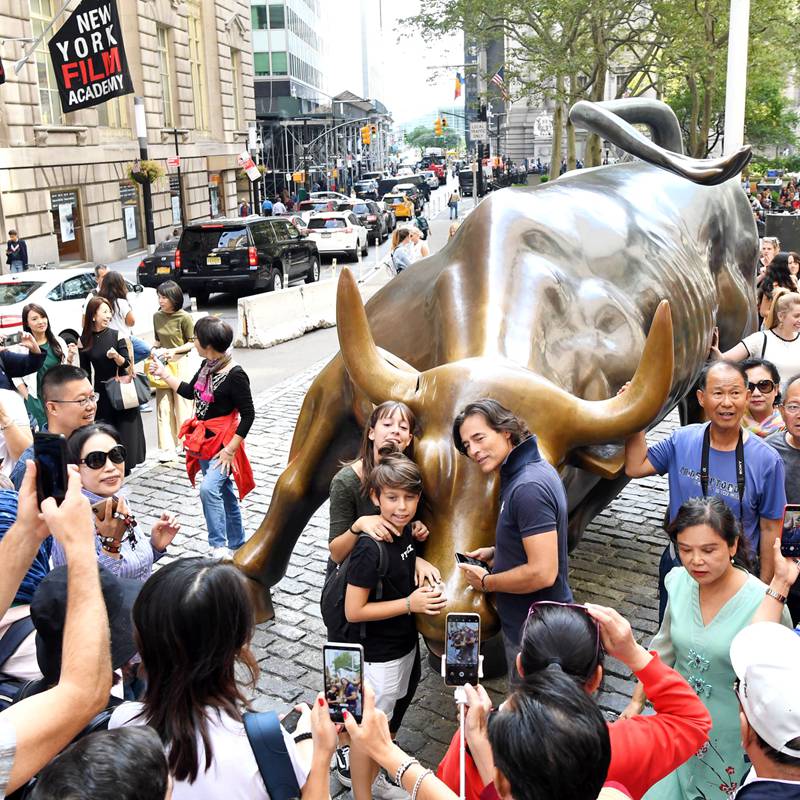
The origin of the Charging Bull can be traced back to Di Modica’s desire to convey a message of hope and recovery following the 1987 stock market crash. The artist wanted to inspire confidence and convey the indomitable spirit of the American people. Di Modica spent two years creating the sculpture, which depicts a muscular bull with its head lowered and ready to charge.
The symbolism of the Charging Bull is multi-faceted. The bull itself is a traditional symbol of strength, power, and abundance in various cultures, including in the world of finance. It represents the aggressive and bullish nature of stock markets, where investors seek growth and financial success.

The location of the Charging Bull, near the New York Stock Exchange, further reinforces its symbolism. It has become an iconic landmark associated with Wall Street and the global financial industry. The sculpture has also come to symbolize the entrepreneurial spirit, determination, and resilience of the American people.
Since its unauthorized installation, the Charging Bull has gained significant popularity and has become a major tourist attraction. It continues to be a symbol of economic vitality and a source of inspiration for visitors from around the world. The sculpture’s bold presence and symbolic significance have made it an enduring symbol of financial prosperity and the American Dream.
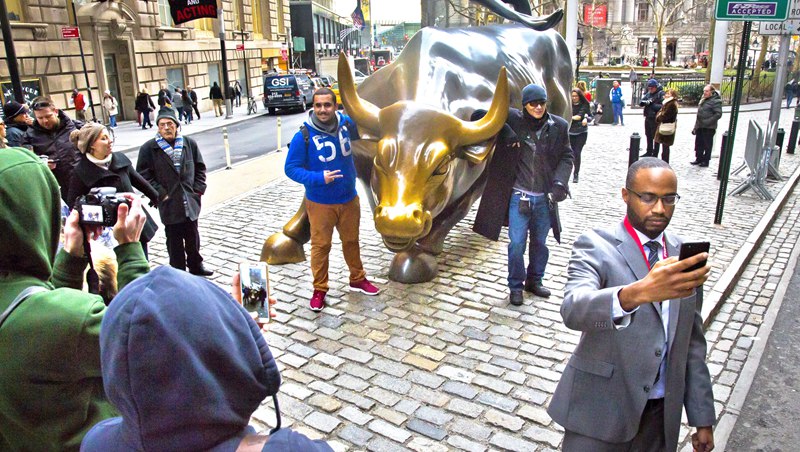
5. Discobolus, Greece
Origins and Significance of the Discobolus Statue
The Discobolus, also known as the Discus Thrower, is an ancient Greek sculpture depicting a male athlete in the act of throwing a discus. It is one of the most iconic and influential sculptures of classical antiquity.
The statue is believed to have been created by the ancient Greek sculptor Myron during the 5th century BCE. It was originally made of bronze, but the original Greek statue has been lost, and the surviving copies are mostly Roman marble replicas.
The Discobolus captures a frozen moment of intense physical movement and athleticism. The figure is depicted in a dynamic pose, with his body twisted and his weight shifted to one leg as he prepares to release the discus. The sculpture embodies the harmony of balance, rhythm, and proportion that characterized classical Greek art.
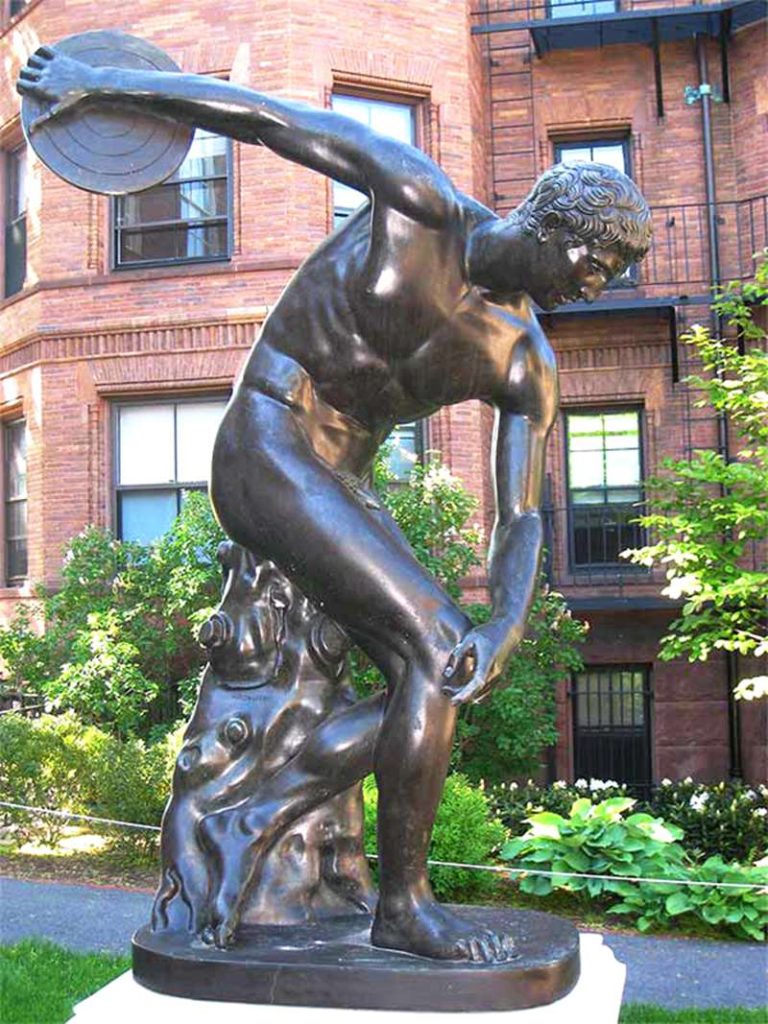
The significance of the Discobolus lies in its celebration of the human form and the ideals of physical beauty, strength, and athletic prowess. In ancient Greece, sports and athletic competitions were highly regarded, and the sculpture represents admiration for the achievements of the human body.
The Discobolus also reflects the Greek philosophical concept of arete, which refers to the pursuit of excellence and the fulfillment of one’s potential. The athlete’s intense concentration and focus on the throw embody the Greek ideals of discipline, skill, and the quest for perfection.
Throughout history, the Discobolus has inspired countless artists and sculptors. Its powerful depiction of human anatomy and movement has influenced the development of art in various periods, including the Renaissance and Neoclassical eras.
Today, the Discobolus is considered an emblem of ancient Greek culture and a symbol of the timeless pursuit of physical and artistic excellence. Its enduring legacy as a masterpiece of sculpture continues to captivate and inspire viewers, serving as a testament to the enduring power and influence of classical Greek art.

6. The Great Buddha of Kamakura, Japan
Origins and Significance of the Great Buddha of Kamakura
“The Great Buddha of Kamakura” is a monumental outdoor bronze statue located in Kamakura, Japan. This majestic sculpture depicts Amida Buddha, a central figure in Buddhism, and serves as a significant symbol of the religion.
The statue was constructed in the 13th century and stands at a height of approximately 43 feet (13 meters), making it one of the largest Buddha statues in Japan. It was originally housed inside a large temple, but over the centuries, the temple was destroyed by natural disasters, and the statue now stands in the open air.
The Great Buddha of Kamakura represents the Amida Buddha, who is believed to guide souls to the Pure Land, a realm of enlightenment and liberation. The statue’s serene expression, gentle demeanor, and crossed legs in the lotus position exude a sense of peace, compassion, and enlightenment.
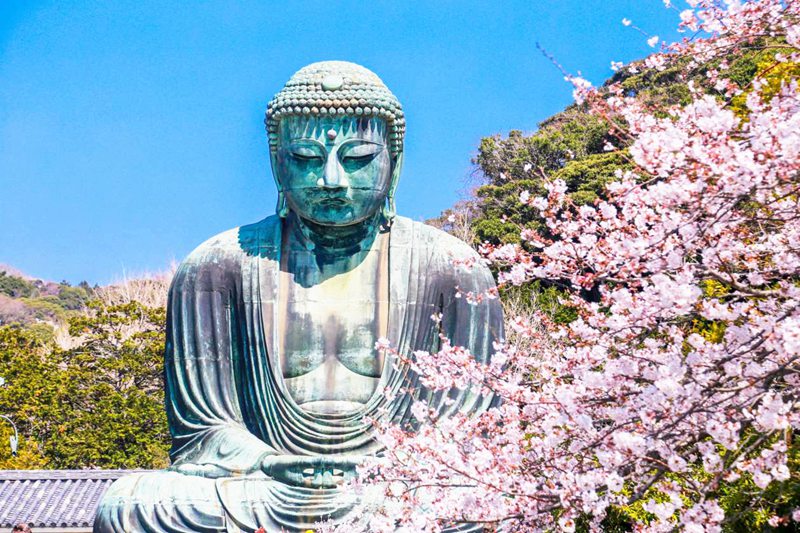
The sculpture’s significance extends beyond its religious symbolism. It serves as a cultural and historical landmark, attracting visitors from around the world who come to marvel at its grandeur and appreciate its artistic and architectural beauty.
The statue’s creation is attributed to the renowned sculptor Ono Gorōemon, and its construction required a team of skilled craftsmen and engineers. It is made of bronze, with an inner wooden structure providing stability. Over the centuries, the statue has undergone repairs and restorations to maintain its integrity and preserve its cultural heritage.
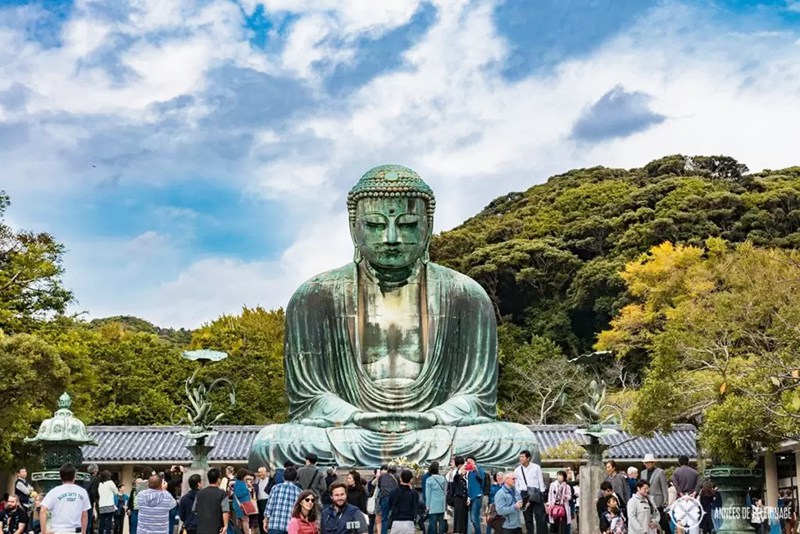
Surrounded by a serene and peaceful environment, the Great Buddha of Kamakura offers visitors a tranquil space for contemplation and reflection. It has become a pilgrimage site for Buddhists and a popular tourist destination for those seeking spiritual solace and cultural enrichment.
The statue’s enduring presence symbolizes the timeless teachings of Buddhism, promoting peace, compassion, and inner awakening. It stands as a testament to Japan’s rich religious and artistic traditions, leaving a profound impact on all who encounter its awe-inspiring presence.
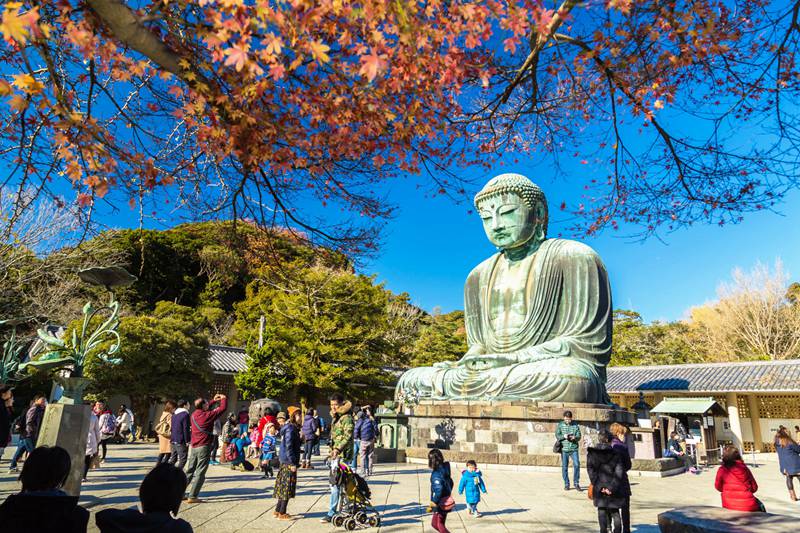
7. The Bex Eagle, Washington, D.C.
Introduction of The Bex Eagle
Ghiglieri’s sculptures are renowned for their exceptional craftsmanship and artistic brilliance, and one of his notable works is “The Bex Eagle.”
“The Bex Eagle” is a captivating sculpture that showcases Ghiglieri’s mastery in capturing the essence and beauty of the majestic eagle. This remarkable artwork depicts an eagle in flight, with its wings spread wide and its powerful gaze fixed ahead. The intricate detailing of the feathers and the dynamic pose bring the sculpture to life, conveying a sense of strength, grace, and freedom.
The Bex Eagle has garnered widespread acclaim for its impressive size and lifelike representation of the eagle. Standing tall and proud, this sculpture stands as a symbol of power and resilience, embodying the spirit of these magnificent creatures. Ghiglieri’s meticulous attention to detail and his ability to capture the essence of the eagle make “The Bex Eagle” a truly remarkable piece of art.
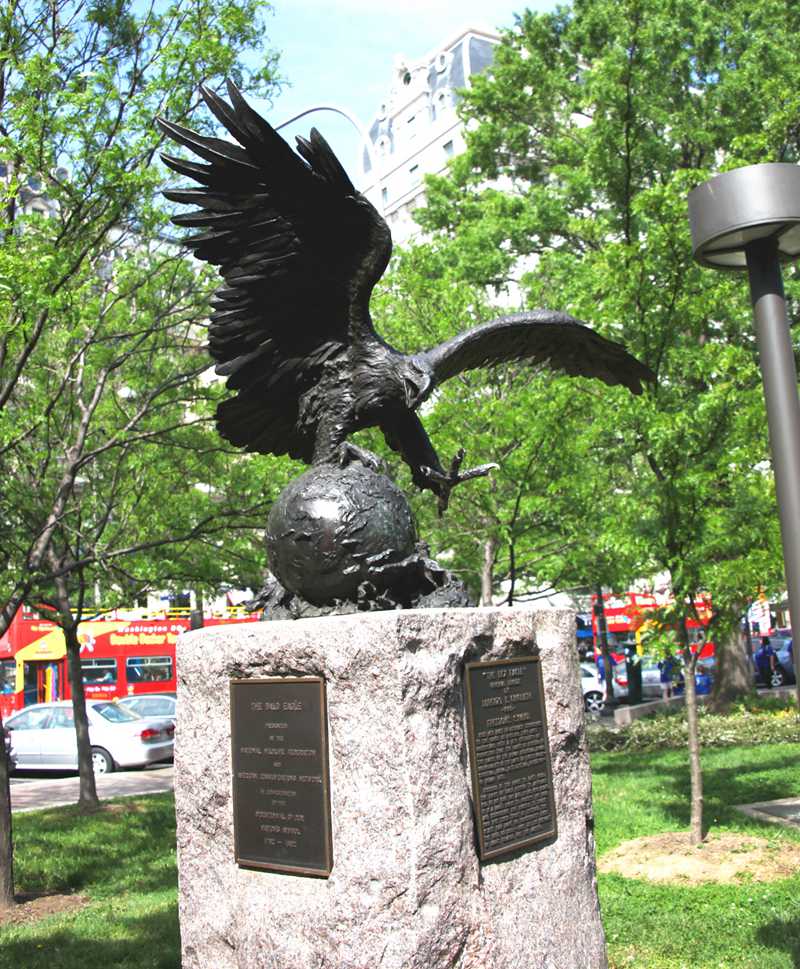
This extraordinary sculpture has been exhibited in various galleries and art shows, captivating viewers with its striking presence and artistic finesse. Its powerful symbolism and aesthetic appeal have made it a sought-after artwork among collectors and art enthusiasts alike.
“The Bex Eagle” serves as a testament to Ghiglieri’s artistic talent and his ability to bring nature to life through his sculptures. It not only showcases the beauty of eagles but also instills a sense of awe and admiration for these majestic creatures and the natural world they represent.
With its commanding presence and captivating artistry, “The Bex Eagle” stands as a testament to Ghiglieri’s skill and creativity, leaving a lasting impression on all who have the privilege of experiencing it.
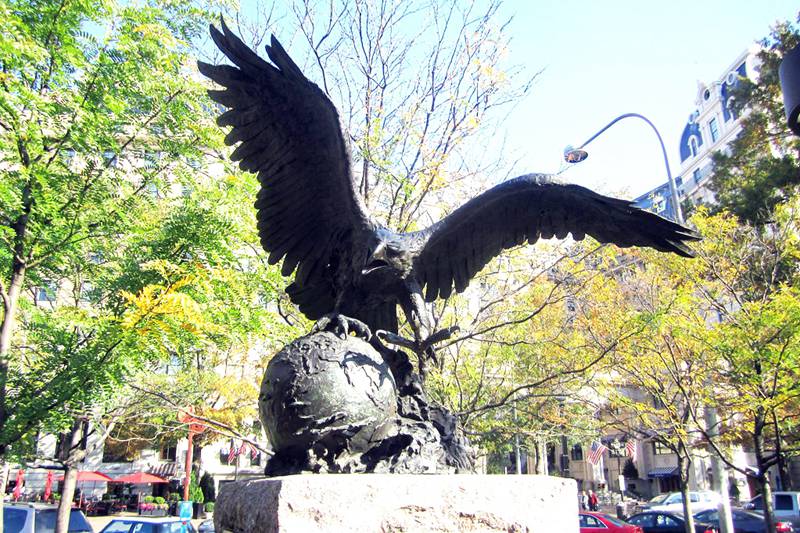
8. Lion and Serpent, Orangerie Museum
Bronze Lion and Serpent Statue Details
Antoine-Louis Barye was a renowned French sculptor who lived from 1796 to 1875. He is best known for his exceptional talent in depicting animals, and his masterpiece “Lion and Serpent” exemplifies his skill and creativity. Barye’s fascination with the natural world and his extensive studies of animal anatomy deeply influenced his work. He sought to capture the essence and spirit of the animals he sculpted, bringing them to life with a remarkable level of detail and realism.
“Lion and Serpent” portrays a powerful lion standing triumphantly over a writhing serpent, symbolizing the eternal struggle between good and evil. Barye’s ability to convey the tension and drama of this moment showcases his mastery of form and composition. His innovative approach to sculpture and his dedication to capturing the intricacies of animal behavior have made him one of the most celebrated animal sculptors in history.
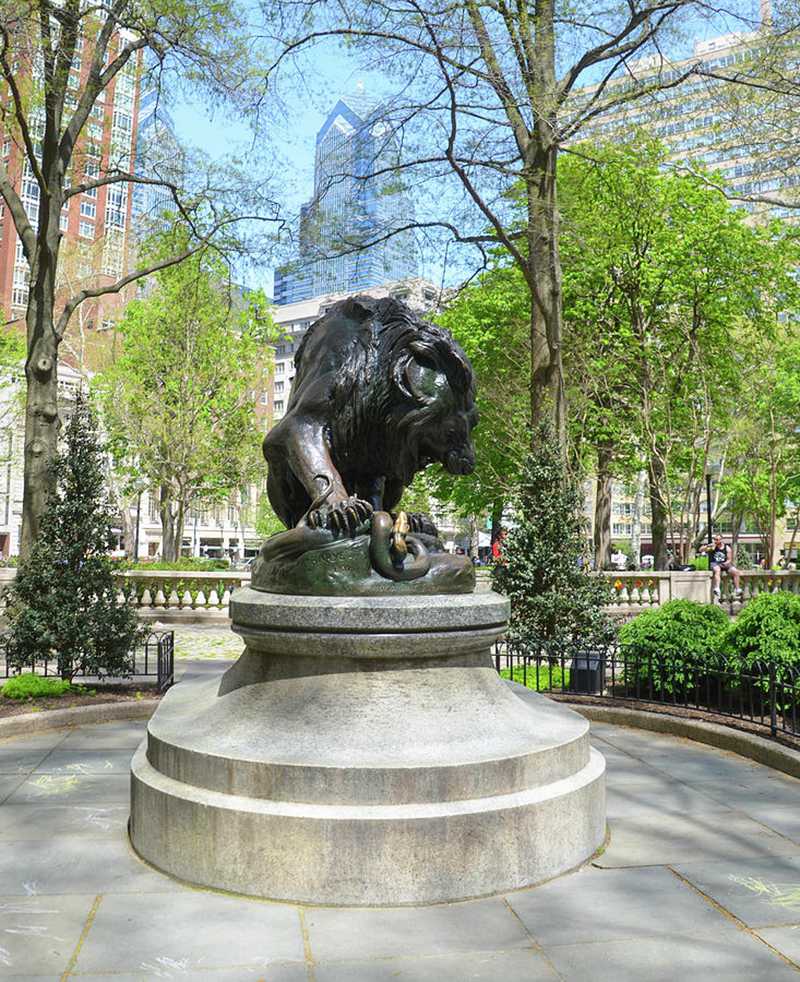
The original placement of Antoine-Louis Barye’s “Lion and Serpent” sculpture was in the Jardin des Tuileries in Paris, France. The sculpture was installed there in 1832 and remained in the garden until it was moved to the Musée du Louvre in 1940 for safekeeping during World War II. After the war, it was returned to the Jardin des Tuileries and placed near the Orangerie Museum, where it can still be seen today.
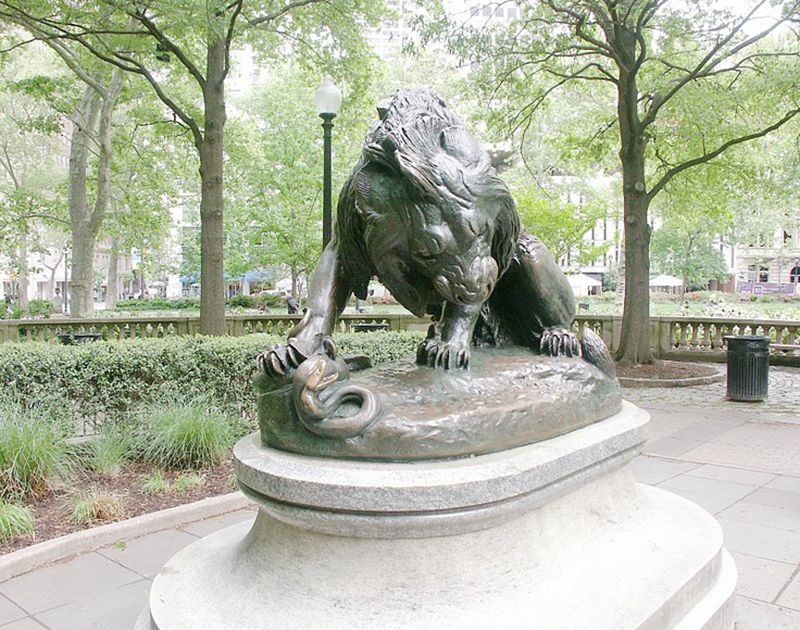
9. Bust of a Woman, Picasso exhibition space
Depicts an Abstract and Fragmented Style
One of Picasso’s most famous bronze sculptures is called “Bust of a Woman” or “Tête de Femme” in French. It was created in 1943 and showcases Picasso’s innovative approach to sculpture. The sculpture depicts the head of a woman in an abstract and fragmented style, characteristic of Picasso’s Cubist period. With its bold lines and geometric forms, “Bust of a Woman” exemplifies Picasso’s mastery of form and his ability to capture the essence of the subject. The sculpture is widely recognized as an iconic piece in Picasso’s body of work and is held in various prestigious art collections around the world.
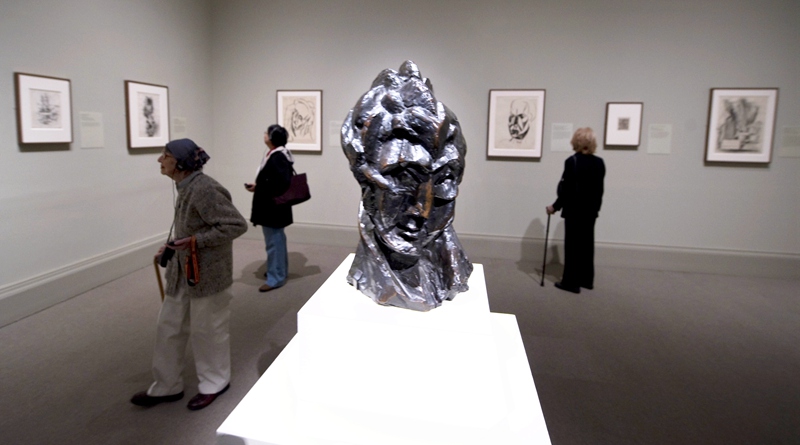
10. The Broadgate Venus, London
Striking Artwork Depicts a Voluptuous Female Figure
One of Fernando Botero’s most renowned bronze sculptures is “The Broadgate Venus” or “La Venus de Broadgate” in Spanish. This striking artwork depicts a voluptuous female figure, characteristic of Botero’s signature style. The sculpture showcases Botero’s fascination with volume and form, as he emphasizes the figure’s exaggerated curves and proportions. “The Broadgate Venus” has captivated audiences around the world and has been displayed in prominent public spaces, galleries, and museums. Its prominent presence and Botero’s unique interpretation of the female form make it an iconic piece in the artist’s body of work.
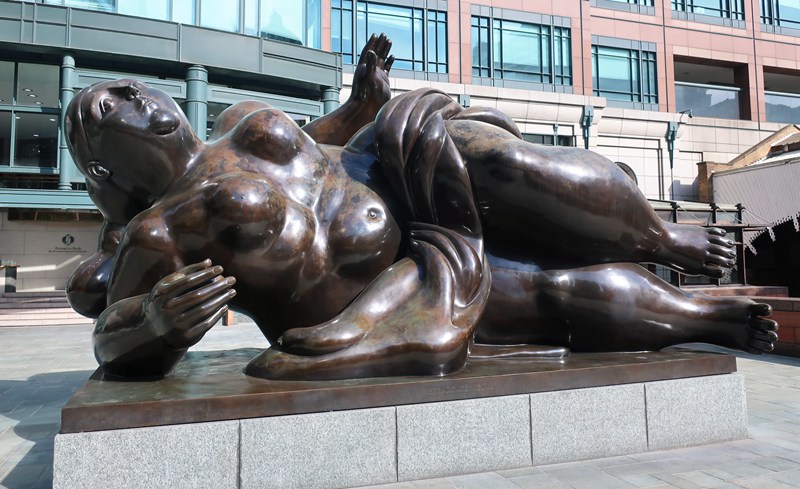
“The Broadgate Venus” by Fernando Botero was initially exhibited in Broadgate, an expansive office and retail complex located in the City of London, England. The sculpture was installed in the central plaza of Broadgate as part of a public art initiative. Its prominent placement in this bustling urban environment allowed it to capture the attention and admiration of visitors and passersby. Over time, “The Broadgate Venus” has become synonymous with the Broadgate area and has become an iconic symbol of the artistic and cultural landscape of London.
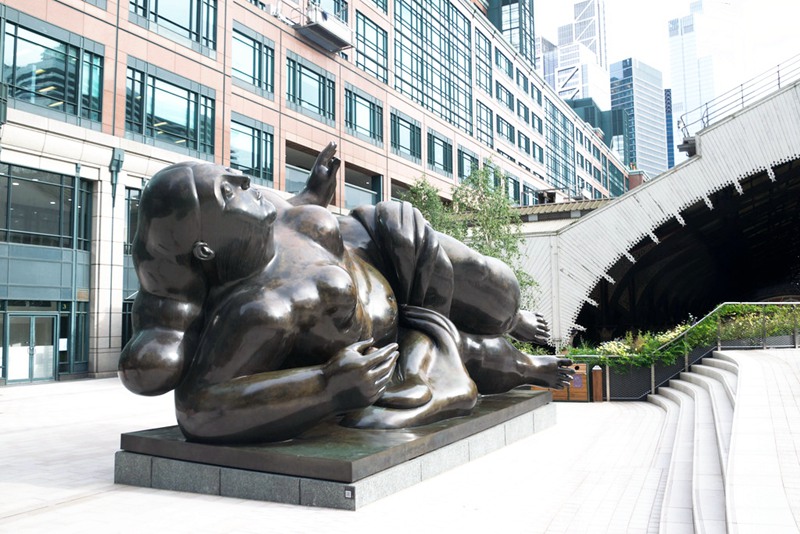
11. The Hand of God, Italy
The Hand Sculpture Symbolizes the Strength
One of Lorenzo Quinn’s most renowned bronze sculptures is titled “Support” or “The Hand of God” in English. This striking artwork features a pair of colossal hands emerging from the ground, with one hand supporting a building or structure. The sculpture symbolizes the strength and support needed to overcome challenges and adversity. It’s powerful imagery and thought-provoking concept have garnered widespread acclaim and admiration from art enthusiasts around the world. “Support” has been exhibited in various international locations, captivating viewers with its awe-inspiring presence and profound message.
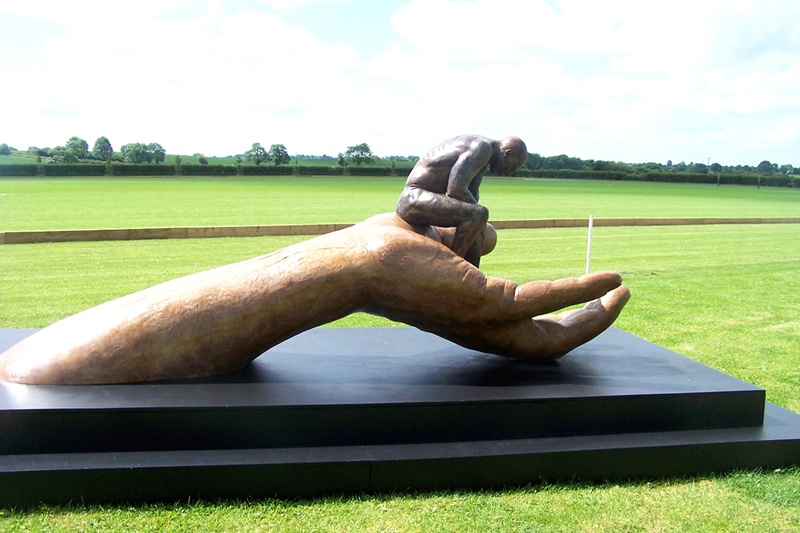
“The Hand of God” sculpture by Lorenzo Quinn was initially exhibited in Venice, Italy. It was first unveiled during the 2017 Venice Art Biennale, one of the world’s most prestigious contemporary art events. The sculpture captivated audiences with its monumental scale and emotive symbolism. Since its debut in Venice, “The Hand of God” has been showcased in various prominent locations and art exhibitions worldwide, leaving a lasting impression on viewers with its powerful message of unity, strength, and the transcendence of human limitations.
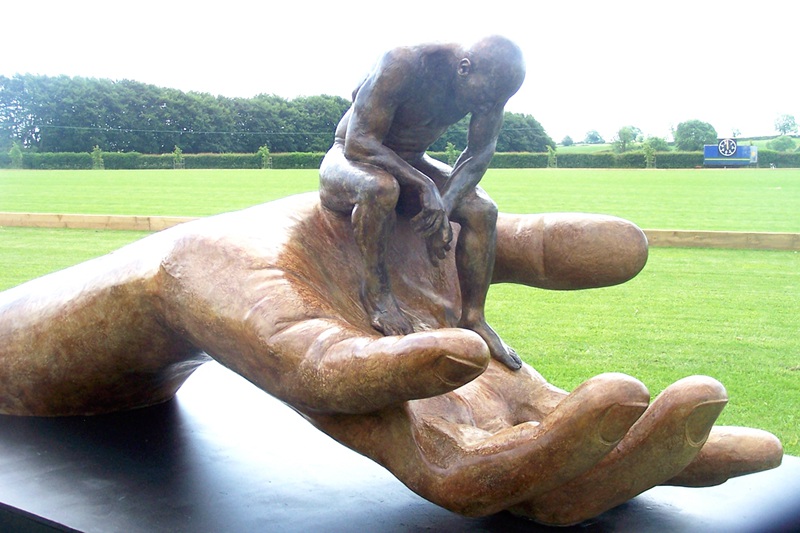
12. The Persistence of Memory, New York
Evoking a Sense of Timelessness
Salvador Dali is widely celebrated for his surrealist paintings, although he did create a notable bronze sculpture called “The Persistence of Memory.” This sculpture is a three-dimensional rendition of Dali’s renowned painting, which showcases melting clocks in a dreamlike and surreal composition. Just like its painted counterpart, the bronze sculpture captures the essence of Dali’s artistic style, evoking a sense of timelessness, subconscious exploration, and the distortion of reality. “The Persistence of Memory” sculpture stands as a testament to Dali’s imaginative vision and his ability to transcend traditional artistic boundaries.
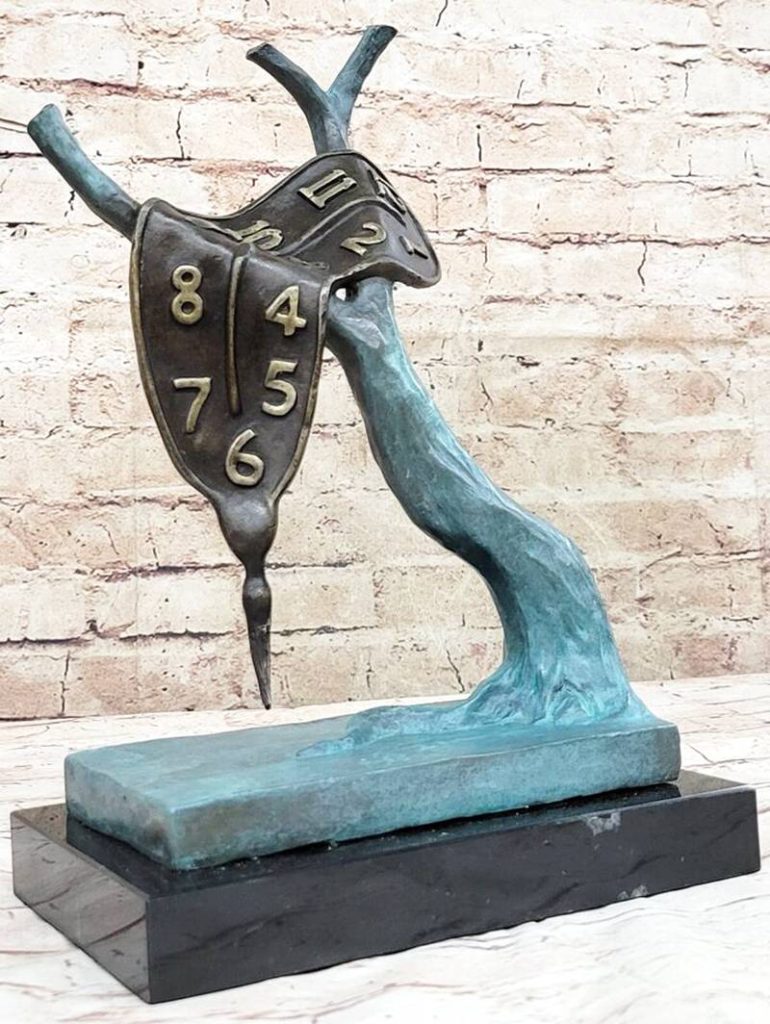
“The Persistence of Memory” bronze sculpture was initially exhibited at the Museum of Modern Art (MoMA) in New York City. It was first displayed in 1932 as part of Dali’s solo exhibition at the museum. The sculpture’s debut at MoMA marked a significant moment in art history, introducing Dali’s surrealistic vision to a wider audience and solidifying his status as a pioneering artist of the 20th century. Today, “The Persistence of Memory” is considered one of Dali’s most iconic works and continues to captivate viewers with its enigmatic and thought-provoking imagery.
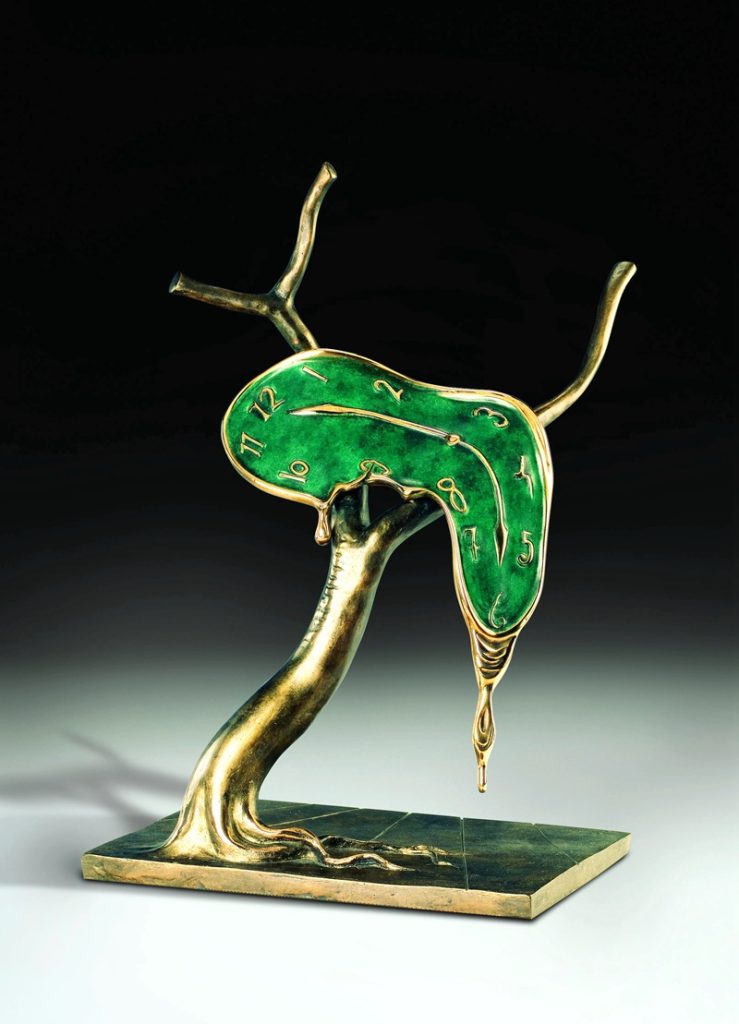
13. Single Form, New York
Captivate Audiences With its Timeless Beauty
One of Barbara Hepworth’s most renowned bronze sculptures is titled “Single Form” or “Monolith-Empyrean.” Crafted in 1961, this vertical and abstract artwork exemplifies Hepworth’s profound exploration of the interplay between form and space. The sculpture showcases a sleek, curvaceous surface that beckons viewers to reflect and engage with its surrounding environment. “Single Form” is highly regarded for its seamless equilibrium and its ability to encapsulate the essence of Hepworth’s modernist and organic sculptural approach. It stands as a testament to Hepworth’s artistic vision and continues to captivate audiences with its timeless beauty.
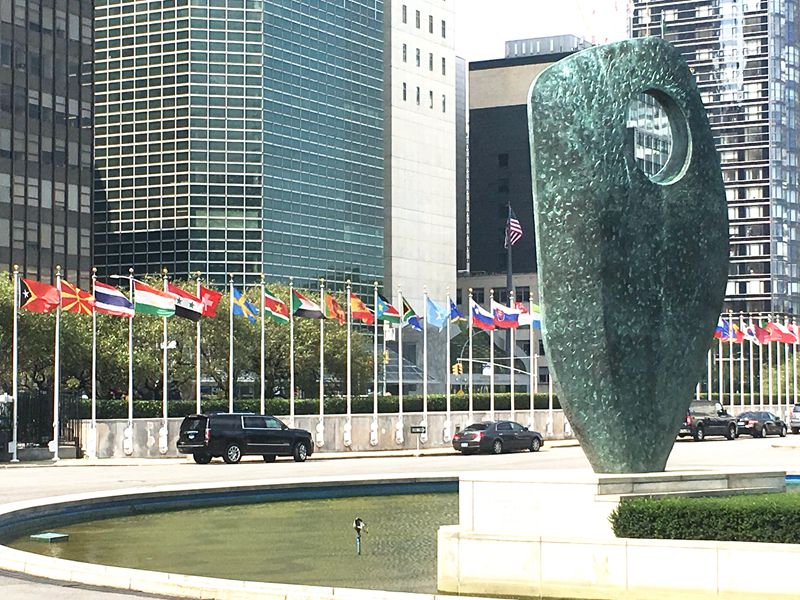
The “Single Form” sculpture by Barbara Hepworth was initially displayed at the United Nations Headquarters in New York City. Its inaugural placement at this significant location allowed the artwork to be seen and appreciated by a diverse and global audience. The sculpture’s presence at the United Nations emphasized its symbolic and universal themes of unity, harmony, and the interconnectedness of humanity. Since then, “Single Form” has been showcased in various prestigious exhibitions and public spaces, solidifying its status as a significant and impactful piece of art.
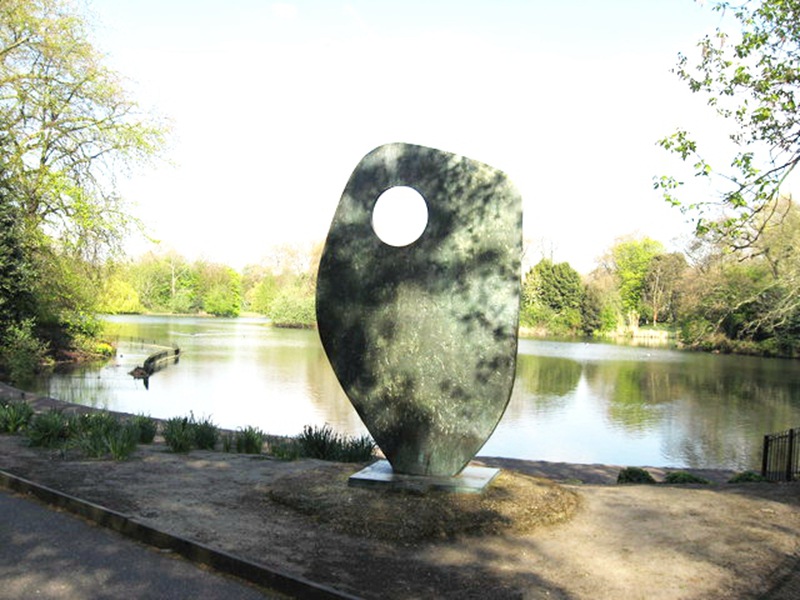
14. Traveler Statue, United States
Capturing the Spirit of a Wanderer
Discover a captivating bronze sculpture that embodies the essence of modernity and exploration – the Traveler. This extraordinary artwork invites you to embark on a visual journey as you encounter its striking form and alluring presence. Standing tall and resolute, the Traveler emanates a sense of curiosity and adventure, capturing the spirit of a wanderer exploring the vast unknown. From its exterior to its captivating silhouette, every angle of this bronze masterpiece tells a story.
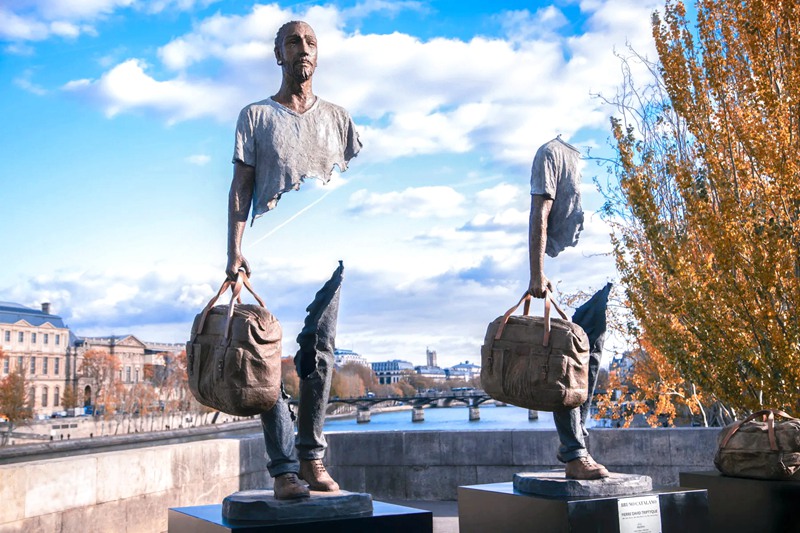
The sculpture’s dynamic lines and fluid contours reflect a sense of movement as if frozen in time during a momentous expedition. The Traveler’s face, though devoid of specific features, portrays a contemplative expression that evokes a multitude of emotions and experiences. This modern bronze sculpture resonates with a universal longing for exploration and discovery, inviting viewers to embark on their own personal odyssey.
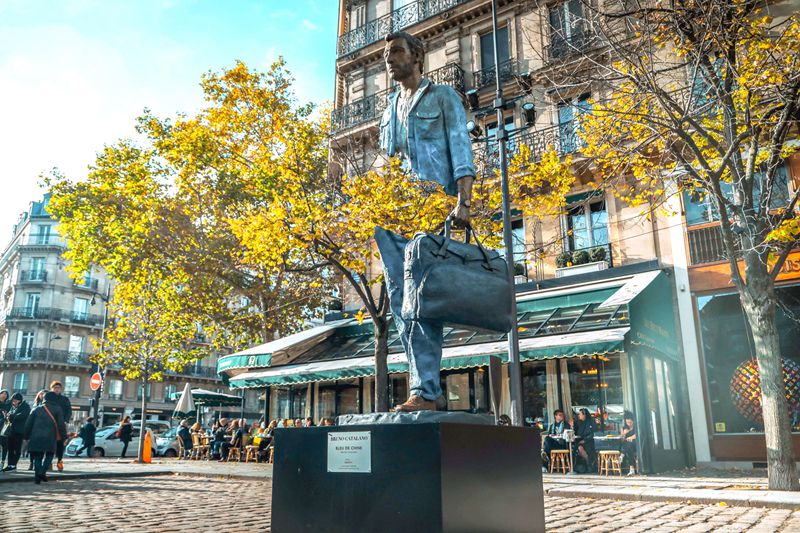
The Traveler statue was initially exhibited in a prominent public space in the heart of a bustling city, capturing the attention and imagination of passersby. Placed strategically at the entrance of a renowned cultural institution, it welcomed visitors into a world of artistic wonder and intellectual exploration. The statue’s placement near a vibrant pedestrian area allowed for a seamless integration with the urban landscape, where people from all walks of life could engage with its intriguing presence. Its initial exhibition location served as a focal point, drawing admirers who were captivated by its modernity and the enigmatic aura it exuded. The Traveler statue’s strategic placement ensured that it became a cherished landmark, a symbol of artistic expression, and a source of inspiration for generations to come.
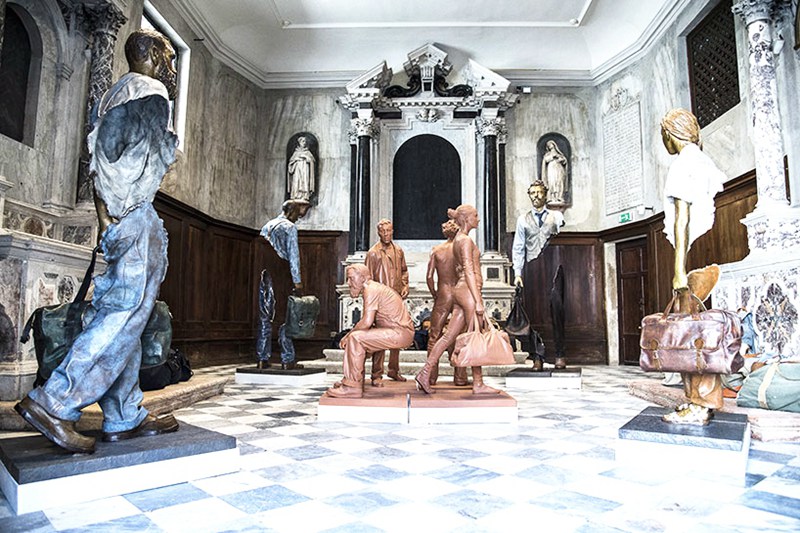
15. The Walking Man, Paris
Conveys a Sense of Vitality and Energy
The Walking Man is a sculpture known for its slender and elongated figure. Created by an acclaimed artist, this bronze sculpture depicts a human figure in mid-stride, capturing the dynamic and rhythmic movement of walking. The sculpture showcases a sense of balance and poise, with its graceful and fluid lines. The slender physique of the figure adds to its elegance and creates a sense of lightness. The Walking Man represents the beauty of human motion and conveys a sense of vitality and energy.
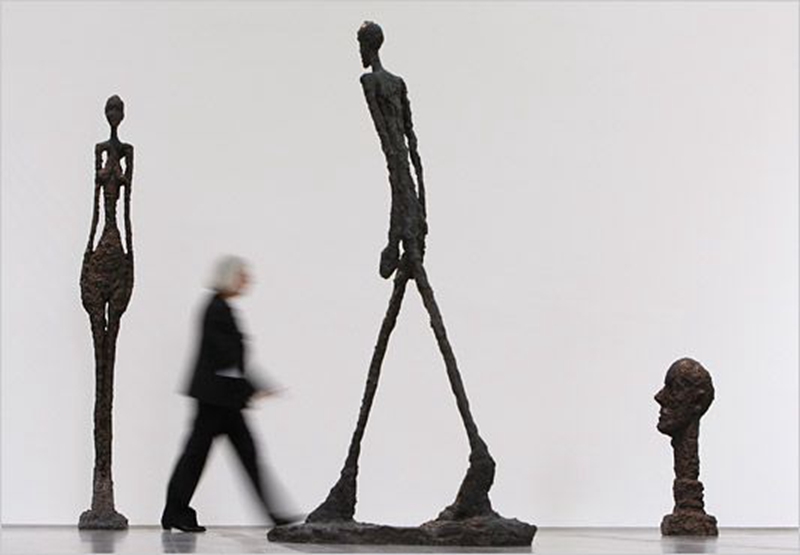
The Walking Man statue, originally known as “L’Homme qui marche,” is a renowned bronze sculpture. It was first exhibited in 1961 at the Pierre Matisse Gallery in Paris, France. The sculpture depicts a slender, elongated figure in mid-stride, capturing a sense of movement and dynamism. Giacometti’s intention was not to create a realistic representation of a walking man but to capture the essence of human existence and the universal experience of movement.
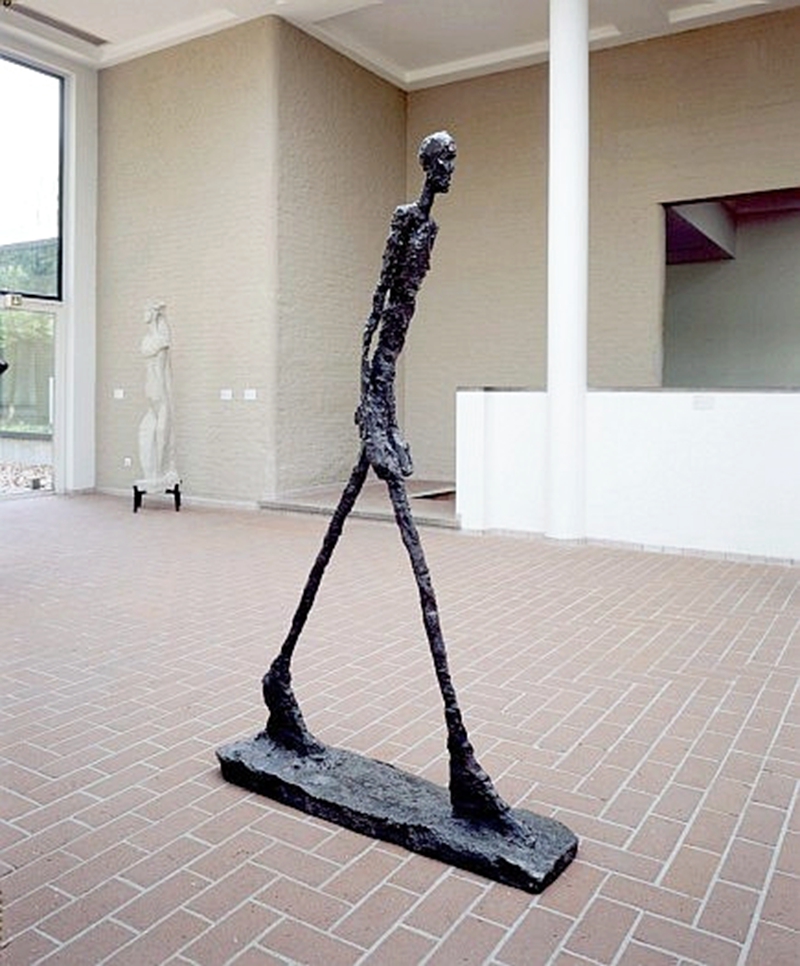
The original location of The Walking Man statue was the Pierre Matisse Gallery, where it made its debut. Since then, it has been displayed in various prestigious art museums and public spaces around the world, including the Museum of Modern Art (MoMA) in New York City, the Tate Modern in London, and the Alberto Giacometti Foundation in Switzerland. Its presence in these prominent institutions has allowed audiences from different cultures and backgrounds to appreciate Giacometti’s profound artistic vision and engage with the universal themes conveyed by The Walking Man statue.
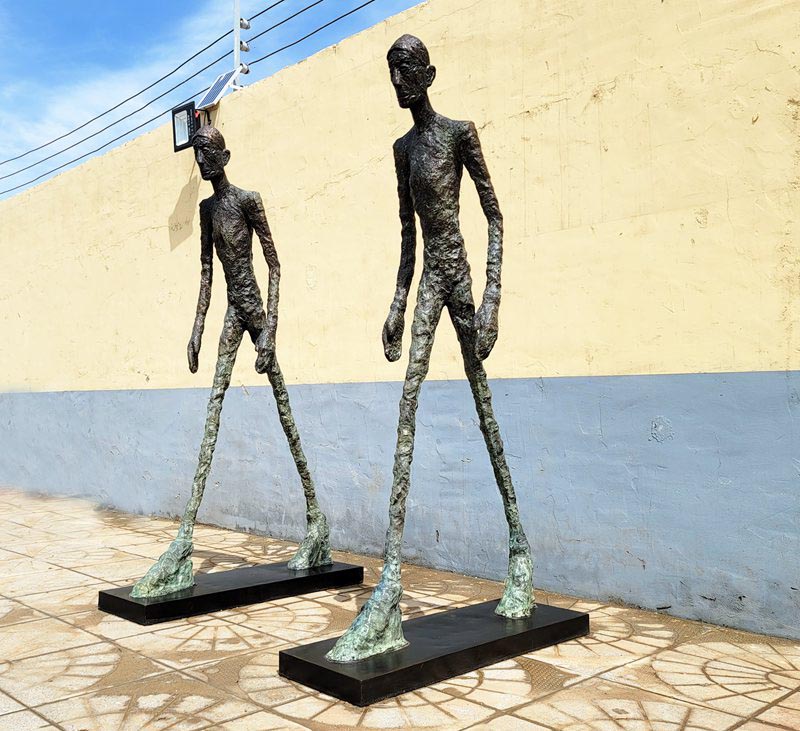
Bronze Statues have Played a Significant Role
Throughout history, bronze statues have played a significant role in the artistic and cultural landscape. From towering monuments to delicate sculptures, these masterpieces have captured the imagination of people across generations. In our journey through the most famous and popular bronze statues, we have encountered exceptional works that hold great artistic, cultural, and historical significance.
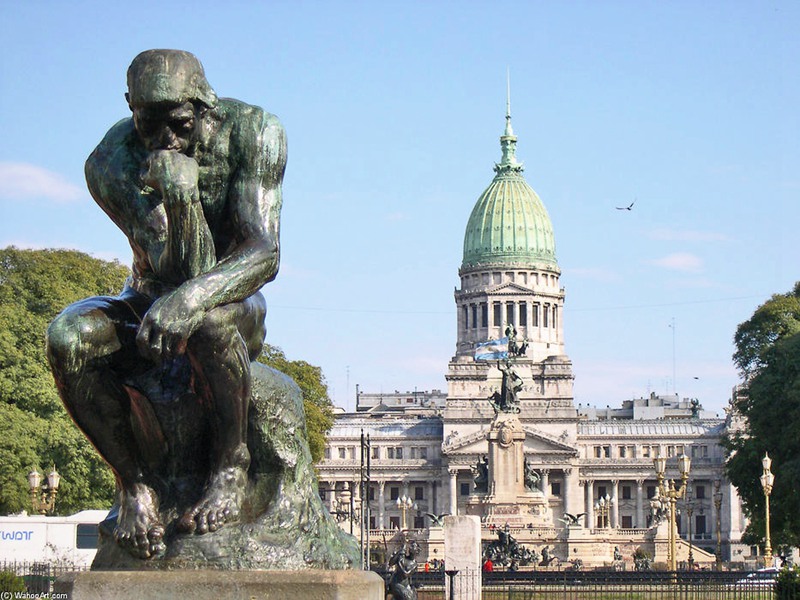
The Statue of Liberty stands proudly as a beacon of freedom and opportunity in the United States, while The Thinker by Auguste Rodin symbolizes the power of contemplation and intellectual pursuit in France. Denmark’s Little Mermaid enchants viewers with its whimsical portrayal of a beloved fairy tale character. The Charging Bull in New York City embodies strength and resilience, representing the spirit of America.

We then travel back in time to ancient Greece, where the Discobolus showcases the pursuit of physical excellence. The Great Buddha of Kamakura in Japan invites us to reflect on inner peace and spiritual serenity. The Bex Eagle in Washington, D.C., exhibits the beauty and majesty of nature through its impressive stature.
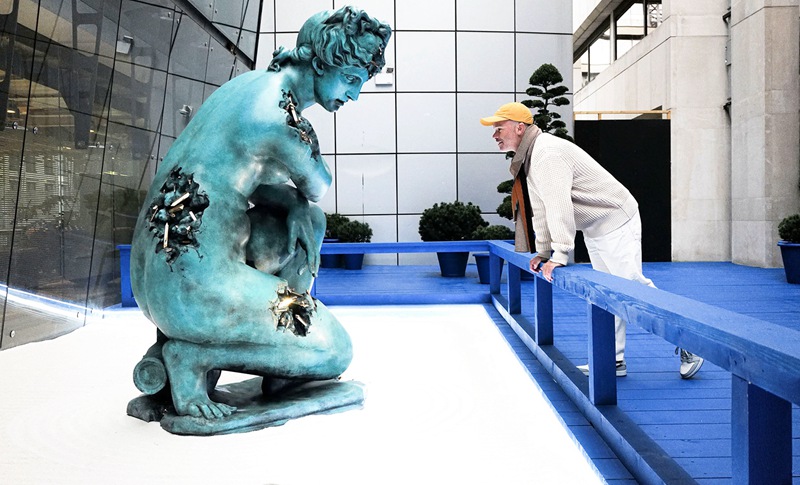
And the Lion and Serpent sculpture captivates with its symbolic depiction of the eternal struggle between good and evil. Picasso’s Bust of a Woman challenges conventional beauty standards, while Fernando Botero’s Broadgate Venus celebrates the female form. Salvador Dali’s The Persistence of Memory invites us into a surreal world, and Barbara Hepworth’s Single Form harmonizes form and space.
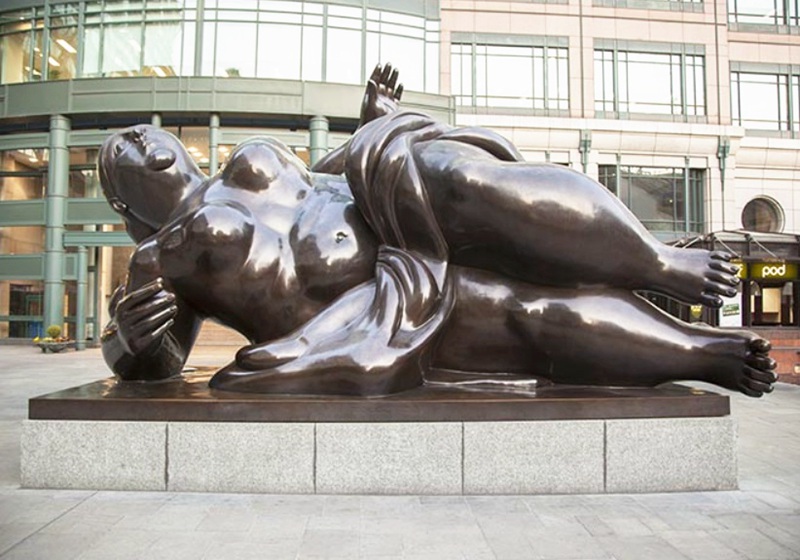
The Traveler Statue represents the spirit of exploration and adventure, and the Walking Man captures the essence of movement and human existence. These iconic sculptures invite us to contemplate the human experience and our place in the world. Luolirong’s sculptures serve as a visual representation of the human condition, capturing moments of introspection, grace, and interconnectedness.
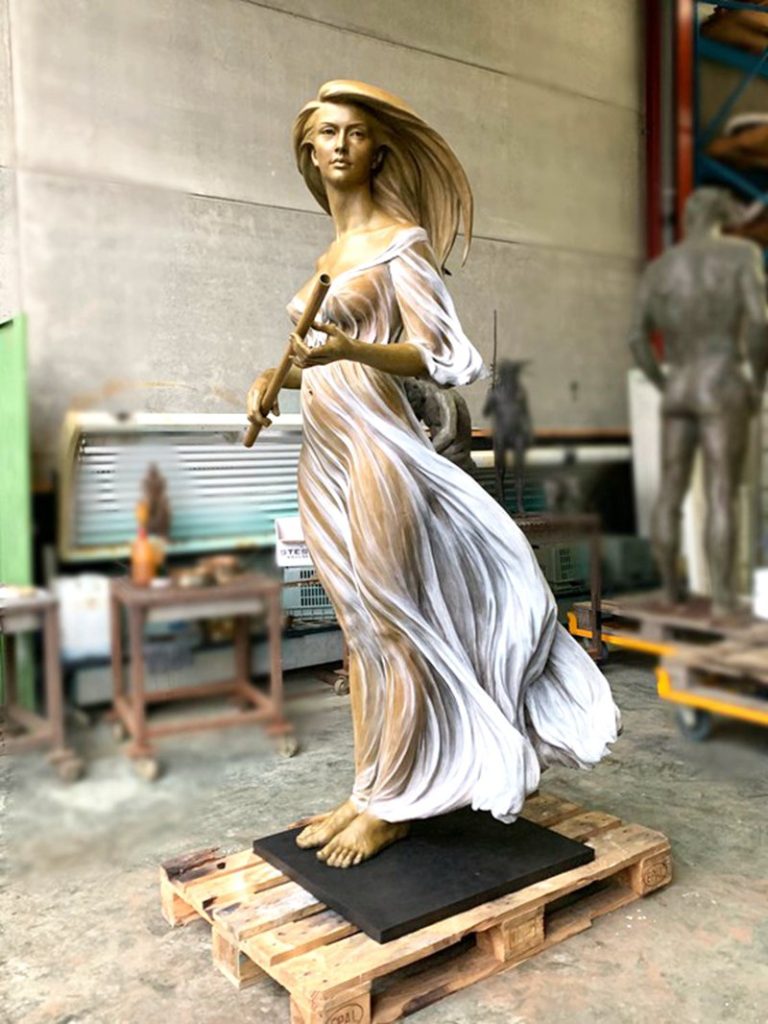
you can embrace the artistry, cultural richness, and historical significance of these bronze statues. Take the opportunity to explore and appreciate these iconic works, which continue to inspire and captivate audiences worldwide.